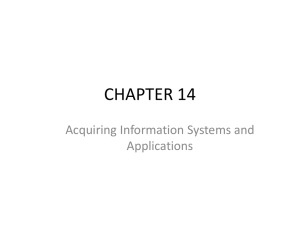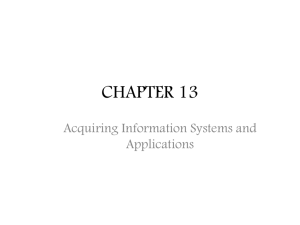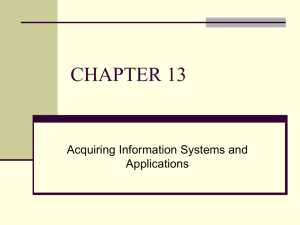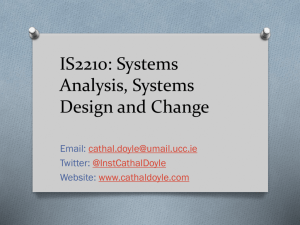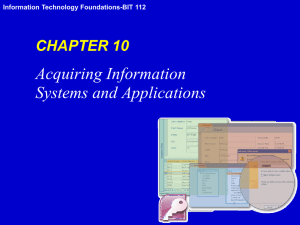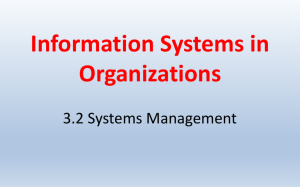ch14-2015
advertisement
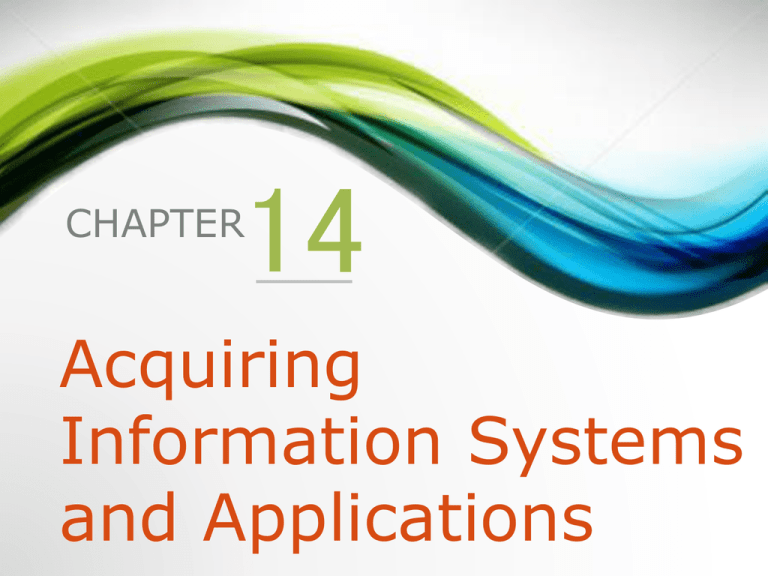
14 CHAPTER Acquiring Information Systems and Applications 1. Planning for and Justifying IT Applications 2. Strategies for Acquiring IT Applications 3. The Traditional Systems Development Life Cycle 4. Alternative Methods and Tools for Systems Development 5. Vendor and Software Selection >>> 1. Discuss the different cost–benefit analyses that companies must take into account when formulating an IT strategic plan. 2. Discuss the four business decisions that companies must make when they acquire new applications. >>> 3. Enumerate the primary tasks and the importance of each of the six processes involved in the systems development life cycle. 4. Describe alternative development methods and the tools that augment development methods. 5. Analyze the process of vendor and soft ware selection. OPENING > • LinkedIn’s Fast Development Process Helps Save the Company Describe how freezing new feature development on its Web site “saved” LinkedIn. Describe how rapid application development is enabling LinkedIn to add its next feature, mining users’ economic and job data. 14.1 Planning for and Justifying IT Applications • IT Planning • Evaluation and Justifying IT Investment: Benefits, Costs, and Issues Figure 14.1: IS Planning Process COBIT 5’s Goals Cascade 8 IT Planning • Organizational Strategic Plan • 1. IT Strategic Plan 2. IT Steering Committee 3. IS Operational Plan 1. IT Strategic Plan Three Objectives of an IT Strategic Plan: Must be aligned with the organization’s strategic plan Provide for an IT architecture Efficiently allocate IS development resources 2. IT Steering Committee Major Tasks of an IT Steering Committee Who should be there? Link corporate strategy with IT strategy Approve the allocation of resources for the MIS function Establish performance measures for the MIS function and ensure they are met 3. IS Operational Plan Elements of an IS Operational Plan: Mission IS Environment Objectives of the IS Function Constraints on the IS function Application Portfolio Resource Allocation and Project Management Evaluation and Justifying IT Investment: Benefits, Costs, and Issues • Assessing the Costs • Assessing the Benefits • Conducting the Cost-Benefit Analysis Conducting the Cost-Benefit Analysis Four Common Approaches for CostBenefit Analysis: • Net Present Value • Return on Investment (ROI) • Breakeven Analysis • Business Case Approach More about Cost-Benefit Analysis Issues to be aware and addressed: • Intangible costs • TCO (Total Cost of Ownership) 14.2 Strategies for Acquiring IT Applications • Fundamental Decisions • Acquisition Methods Fundamental Decisions • How much computer code does the company want to write? In-house develop. vs consulting firm devel. • Where will the application run? SaaS option • Where will the application originate? Acquisition Methods 1. 2. 3. 4. 5. 6. 7. 8. Purchase a Prewritten Application Customize a Prewritten Application Lease the Application Application Service Provider (ASP) Software-as-a-Service (SaaS) Use Open-Source Software Outsourcing Employ Custom Development Table 14.1: Advantages & Disadvantages of Buy Option Figure 14.2: Operation of an ASP Figure 14.3: Operation of a SaaS Vendor ’S ABOUT BUSINESS 14.1 • A Disastrous Development Project Debate the lawsuit from the point of view of Deloitte and SAP. Debate the lawsuit from the point of view of Marin County. Is it a good idea for Marin County to attempt another ERP implementation? Why or why not? Support your answer. Are there other types of software that Marin County might use? (Hint: Consider cloud computing (see Plug IT In 4).) Is it a good idea for Marin County to use software products from different vendors? Why or why not? Support your answer. ’S ABOUT BUSINESS 14.2 • General Motors Insources Its Information Technology Function What are potential disadvantages of Mott’s insourcing strategy? Why did GM’s outsourcing strategy result in the company’s using 4,000 software applications? In your opinion, will Mott’s insourcing strategy resolve this problem? Why or why not? ’S ABOUT BUSINESS 14.3 • Build Your Apps Yourself What are the advantages of learning to code so that you can build your own mobile apps? Provide specific examples to support your answer. What are the disadvantages of learning to code so that you can build your own mobile apps? Provide specific examples to support your answer. 14.3 The Traditional Systems Development Life Cycle • Systems Development Life Cycle (SDLC) 1. 2. 3. 4. 5. 6. Systems Investigation Systems Analysis Systems Design Programming and Testing Implementation Operations and Maintenance Figure 14.4: A six-stage SDLC with Supporting Tools SDLC: Systems Investigation • Three Basic Solutions Differences in the degree of action: • Feasibility Study Tech, Econ, Behavioral • Go / No Go Decision Systems Investigation: Three Basic Solutions 1. Do nothing and continue to use the existing system unchanged 2. Modify or enhance the existing system 3. Develop a new system. Systems Investigation: Feasibility Study • Technical Feasibility • Economic Feasibility • Behavioral Feasibility OSU faculty email (1997) SDLC: Systems Analysis The process whereby systems analysts examine the business problem that the organization plans to solve with an IS. • Deliverable: A set of system requirements (or User Requirements) Development Team • • • • Users Systems analysts Programmers Technical specialists • Systems stakeholders CRITICAL: User requirements An IS Project Gone Astray Rainer & Cegielski, (C) Wiley 2010; Fig 14-3: User involvement in different stages 33 SLDC: Systems Design Describes how the system will resolve the business problem. • Deliverable: a set of technical system specifications. • Scope Creep Scope creep in sys proj failure Primary reasons for project failure Unclear or missing business requirements Skipping SDLC phases Failure to manage project scope Scope creep Feature creep Failure to manage project plan Changing technology Systems Design: Technical Specifications • Technical Specifications include following: System outputs, inputs, and user interfaces Hardware, software, databases, telecommunications, personnel, and procedures • A blueprint of how these components are integrated SDLC: Programming and Testing • Programming • Testing Types of software Testing Program/module System acceptance SDLC: Implementation • Implementation Change management Training Related org changes Related cultural changes • Major Conversion Strategies Direct Parallel Pilot Phased ’S ABOUT BUSINESS 14.4 • Avon Writes Off $125 Million on Failed Software Implementation Is the Avon failure the fault of Avon? SAP? IBM? All three? Explain your answer. Recall the discussion of strategic information systems in Chapter 2. Is Avon’s new system a strategic information system? Why or why not? Explain your answer. SDLC: Operations & Maintenance Systems Require Several Types of Maintenance: • Debugging • Updating • Adding Figure 14.5: Comparison of user & Developer Involvement Over the SDLC 14.4 • • • • • Alternative Methods and Tools for Systems Development Joint Application Development Rapid Application Development Agile Development End-User Development Tools for Systems Development Tools for Systems Development • Prototyping • Integrated computer-assisted software engineering (CASE) • Component-based development • Object-oriented development Integrated Computer-Assisted Software Engineering (CASE) Tools • Upper CASE Tools • Lower CASE Tools • Integrated CASE (iCASE) Tools 14.5 Vendor and Software Selection Six Steps in Vendor & Software Selection 1. Identify Potential Vendors 2. Determine the Evaluation Criteria 3. Evaluate Vendors and Packages 4. Choose the Vendor and Package 14.5 Vendor and Software Selection (con’t) Six Steps in Vendor & Software Selection (continued) 5. Negotiate a Contract 6. Establish a Service Level Agreement
